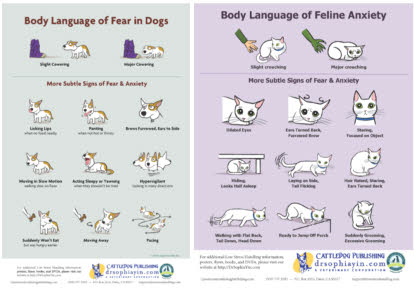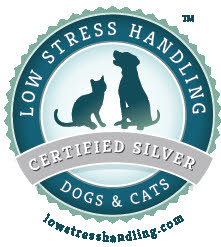As the discipline of reducing stress during veterinary care grows, it helps to have a place where you can find resources. In this post, I have gathered the handouts, blog articles, book chapters, and on-line course content descriptions in one place to help you provide a better care experience for your patients.
At my practice, Okaw Veterinary Clinic, I found that hanging a framed copy of both the dog and cat body language posters helped me and my staff recognize brewing fear and aggression before it escalated. The posters are available to purchase in packs of 100, which make great handouts for clients, or you can download the pdfs for self-printing. At the very least, have the body language posters in all the exam rooms, the waiting area, kennels, and treatment areas. You will be amazed at what behaviors your clients will now recognize in their pet.
There are seven additional posters that provide more Low Stress Handling® tips, including proper greeting techniques, safe child-pet interaction, dog play etiquette, and how to be a nice vet. All these posters are excellent references that can be posted on a wall or given to clients. You can find all the pdf downloads here to download for free or a donation
Start your journey with the book – In her ground-breaking book, Low Stress Handling: Restraint and Behavior Modification of Dogs and Cats (Cattledog Publishing, 2009), Dr. Sophia Yin refined developing techniques of less stressful handling for animal care professionals. This book has clear, color photos of how to improve the practice environment, accurately countercondition and desensitize patients to care, and use low stress safety tools such as muzzles and head halters. The companion DVD is not handouts or forms – it is video of all the photo sessions in the book. The DVD brings the book to life, and you can use the short chapters for staff training sessions.
Dr Yin also offered her many lectures as DVDs and online courses. The Creating the Pet Friendly Hospital, Towel Wrap Techniques for Handling Cats with Skill and Ease, and the Handling, Moving and Restraining of Dogs series are excellent additions to your library. Buy the DVDs here or take the content as an online course at the Low Stress Handling® University.
Webinars – There are additional one hour RACE CE webinars for veterinarians and technicians by Dr. Sally J. Foote, and other authors, that expand on Low Stress Handling® techniques. The Top 5 Low Stress Handling Techniques for Dogs and Cats, Low Stress Handling in Emergency Care, and Behavior Cocktails emphasize the way to quickly develop high skill in the foundational techniques in Low Stress Handling®, and how to adapt these skills for emergency or specialty care.
The Low Stress Handling® Certification program – this self-paced, in-depth, online program provides 20 RACE CE credits. It offers multiple drills in towel wrap techniques collar and head holds for dogs, and positioning animals with an emphasis on bite risk. You have one year to complete the program, and all certified handlers will be listed in our online directory. Clinics and pet care businesses with 51% of certified employees are eligible to be listed as Low Stress Handling® Certified Facility or business.
A wealth of Blog posts are available for your information and to share with clients. You may share or repost a blog article by contacting Questions@cattledogpublishing.com for a permission-to-use form. All credit to the original author of the post, the article date, and reference to Cattledog Publishing must be included when sharing content. The following are just a few examples:
- Building a Low Stress Clinic – (September 17, 2018). This post includes photos and information about how Zionsville Country Vet clinic in Zionsville, Indiana created a Low Stress veterinary clinic from the ground up. There are lots of ideas and information on flooring, cage choices, and floor plans to help you enhance your work place.
- Low Stress Emergency care – yes, it is possible! (February 8, 2018). This blog post presents the ways to reduce patient stress during urgent care.
- Tactile learning and Low Stress Handling – how to go from learning to doing (October 25, 2017) This post discusses the impact of wet labs and taking the time to do short staff training using stuffed animals and pets to practice the techniques. Many veterinary staff are tactile learners – they learn best by hands on training. This post presents how important hands on learning is to make the change in animal care.
As the discipline of Low Stress Handling® grows, so will our resources. I look forward to offering more webinars, handouts, and live speaking and wet lab events to help make this necessary change in animal care. All of these programs are open to anyone and can complement other certification programs in behavior and fear reduction.
Thank you!





